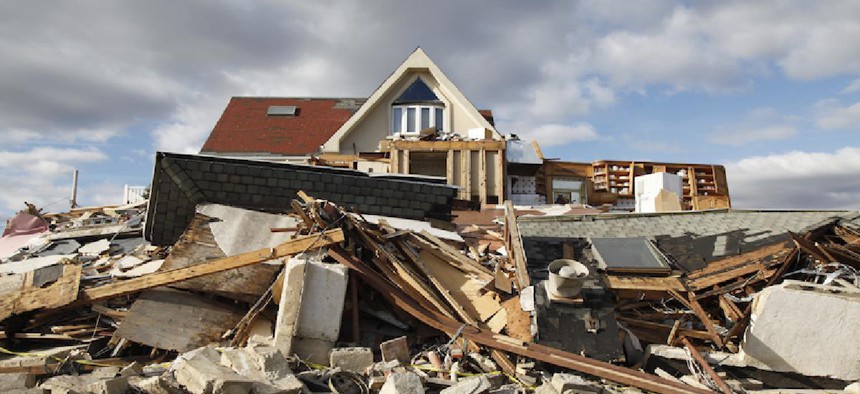Opinion
Learning from Harvey and Sandy

Leonard Zhukovsky / Shutterstock
For those of us who experienced Superstorm Sandy, watching Texas suffer through Hurricane Harvey is like watching a sad sequel to a bad movie. The suffering and sense of loss can be overwhelming, and the acts of everyday heroism are profoundly inspiring.
As of this writing, the water is still rising and tens of thousands remain at risk. Recovery efforts are slowly underway and there’s no mistaking that it will take years to get back to a sense of normalcy.
But there has already been a debate about who should’ve evacuated and when. Let’s be clear, mass evacuation of an entire city is dangerous and infeasible, but selective evacuation of those most vulnerable is prudent. First response is something America is getting better at, and the response to Harvey and Sandy seemed far better than Hurricanes Katrina in New Orleans and Rita on the Gulf Coast of Texas and Louisiana, when many more died. Reconstruction remains riddled with delays, incompetence and bureaucracy; Harvey gives us an opportunity to do better.
RELATED: Lessons of Superstorm Sandy have gone ignored
The intensity and cost of the impact of extreme weather events is growing. There are several reasons for this:
- Our population is growing and more people live in the pathways of storms than before.
- The technology that supports our lifestyle is more extensive and expensive than ever: the vehicles, superhighways, computers, Wi-Fi, smartphones, air conditioning, electric grid, water, sewage and waste management systems are complex and vulnerable.
- Our patterns of development have placed concrete and other impermeable surfaces over environments that could absorb water and wind.
- A warmer climate is making extreme weather events more dangerous.
More and more of us will experience these disasters. Additionally, modern life has created greater dependence on collective infrastructure for energy, water, transportation and sanitation services. We need to recognize our greater interdependency and vulnerability and set aside more resources to respond to emergencies and rebuild after they are over.
The political culture of New York and Texas are as different as night and day. After Sandy, New York City changed its building code, and began investing in the strength and resilience of the infrastructure on the city’s 600 miles of shoreline. Developers are moving building utilities out of basements and onto higher floors. Micro-grids are being incorporated into new real estate developments to encourage renewables and ensure that there is a backup energy source when the grid fails.
Texas didn’t learn the lessons of Sandy, but now they are living through a storm that has caused more damage than the one that hit this region. The emotional wear and tear of an event like Harvey, and the practical necessities of local need, provide an opportunity for pragmatic problem solving.
Ideology is a luxury when a community faces the giant task of reconstruction. Yesterday, Texas Senator Ted Cruz seemed to be less interested in limited government than he was a week ago. New York Senator Chuck Schumer is by nature a practical problem solver. Maybe these two guys can cut a deal. In exchange for the billions needed for reconstruction let’s put in place a permanent funding stream for the flood insurance fund, now $25 billion in debt. Let’s enact a national reconstruction trust fund paid for by (gasp) a new tax on income. This fund would pay for reconstruction and strengthening infrastructure destroyed during natural or human made disasters. It would eliminate the need for hard-hit areas to beg for money from the federal government.
RELATED: How New York can be an environmental leader
The criteria for receiving funds and the level of funding available would be clear and set in advance. There would be no political and bureaucratic processes prior to funding. The trust fund would be paid into by all Americans and would include enough money to ensure that it never ran out. In this way all of us share equally in the payment and all of us have the security of knowing that our homes are fully insured.
The idea that people should be discouraged from living by the shore is built on an ill-informed set of assumptions about the housing market and mobility. Most cities are located near water. Houston is far from alone: New York City, Boston, Los Angeles, Chicago, San Francisco, New Orleans, Miami and nearly every major American city is located near a body of water. Where would everyone go? And as a society, is it really more cost-effective to abandon the shorefront and the billions of dollars we’ve invested in infrastructure? Surely, a more resilient, well-protected community is a better idea than a ghost town. Moreover, what if you moved from the shore only to see your home flooded by a swollen stream? Or destroyed by a tornado or earthquake? Or were the victim of terrorism. Running away is not an option.
One of the lessons of Harvey, Sandy and all the other storms is that these are now regular events and they should probably not be thought of as emergencies. The lesson we need to learn is to assume these disasters will not go away, and be prepared to respond when they occur and rebuild when they are over.
Steven Cohen is the executive director of Columbia University’s Earth Institute and a professor in the practice of public affairs at Columbia University’s School of International and Public Affairs.

NEXT STORY: Vacant lots and properties could house New York City’s homeless